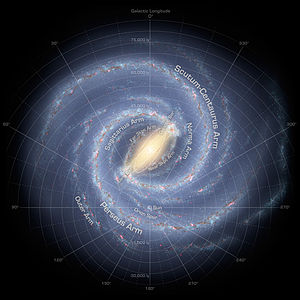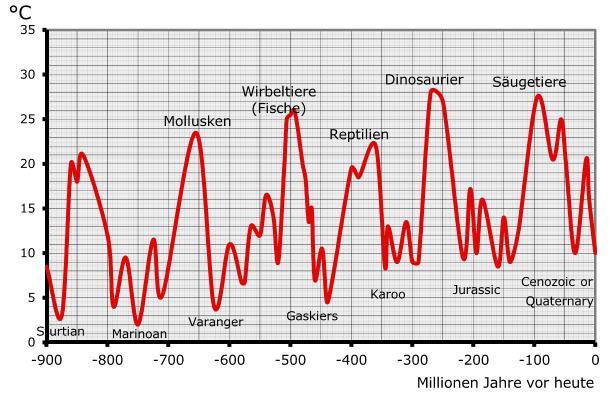Climate change on Mars – is it analogous to that on Earth?
By Dr. Dietrich E. Koelle
[Translated/edited by P Gosselin]

Fig. 1: Structure of the Milky Way (Wikipedia, NASA/JPL-Caltech/R. Hurt)
Drawing conclusions on the development of the Earth’s climate from climate change on Mars would be quite difficult because there is no concrete data from Mars. But it is considerably easier to do this in the opposite direction: The large climate changes on Earth that occurred cyclically about every 150 million years are traced back to a long-term fluctuation in cosmic ray intensity, or simply the radiation variation as to the various cosmic dust density conditions as the solar system traveled through the spiral arms of our Milky Way galaxy.
It is known that the solar system orbits about the center of the Milky Way every 220 million to 240 million years at a distance of 25,000 to 28,000 light years from the center. The Milky Way’s diameter is roughly 100,000 light years.
These radiation intensity fluctuations repeatedly led to global mean temperature extremes here on Earth that ranged from 0°C (Snowball Earth) to 28°C, which saw palm trees in Antarctica (see Fig. 2).
Earth is currently in the middle of an ice age
Approximately 2.5 million years ago a new large ice age began. It is one that we are not really aware of because we happen to find ourselves in one of the 10,000-year relatively warm but brief interglacial periods, which we call the Holocene.
These roughly 10,000-year interglacials have been occurring about every 100,000 years over the past million years.If these extreme temperature fluctuations occurred due to changes in radiation intensity, then they also had to occur on the other planets of our solar system, for example on Mars.As was the case on Earth, this means that considerably higher temperatures would necessarily been the case there 100 million years ago (also 270 million years ago). These warm conditions would have permitted liquid water to exist on the planet’s surface.
Recently traces of such water have been detected on multiple occasions by NASA.

Fig. 2: The temperature history of the Earth saw extreme fluctuations between the hot-house and ice age periods. The horizontal axis has a scale of hundreds of millions of years before present.





“These warm conditions would have permitted liquid water to exist on the plant’s surface.” — *planet’s* surface
Thanks – now fixed
“Earth is currently in the middle of an ice age”
According to Greenland and other Ice Core data our Holocene Interglacial is in decline.
The current, warm Holocene interglacial has been the enabler of mankind’s civilisation for the last 10,000+ years. It’s congenial climate spans from mankind’s earliest farming to the scientific and technological advances of the last 100 years. But:
1 the last millennium 1000AD – 2000AD has been the coldest of the Holocene interglacial.
2 each of the notable high points in the Holocene temperature record, (Holocene Climate Optimum – Minoan – Roman – Medieval – Modern), has been progressively colder than the previous high point.
3 for its first 7-8000 years the early Holocene, including its high point “climate optimum”, had almost flat temperatures, an average drop of only ~0.05 °C per millennium.
4 but the recent Holocene, since the “tipping point” at ~1000BC, has seen a temperature diminution at more than 10 times that earlier rate at more than 0.5 °C+ per millennium.
5 the Holocene interglacial is about 11,000 years old and judging by earlier Interglacials the epoch should be drawing to its close: in this century, the next century or this millennium.
6 any beneficial warming at the end of the 20th century to the Modern high point that has been promoted as the “Great Man-made Global Warming Scare” will come to be seen as noise in the system in the longer term progress of comparatively rapid cooling over the last 3000+ years.
7 other Greenland Ice Core records corroborate this finding.
Global warming protagonists should accept that our interglacial is in long-term decline and that any action taken by man-kind is unlikely to make any difference whatsoever.
Were the actions by Man-kind able to avert warming they would eventually reinforce the catastrophic cooling that is bound to return relatively soon.
see:
http://www.iceandclimate.nbi.ku.dk/data
https://edmhdotme.wordpress.com/2015/06/01/the-holocene-context-for-anthropogenic-global-warming-2/
Earliest ever UK arrival of Siberian Swans indicates longest winter ever.
http://www.telegraph.co.uk/news/weather/11926752/Britain-faces-longest-winter-in-50-years-after-earliest-ever-arrival-of-Siberian-swan.html
Telegraph mentions an unknown substance called “snow” several times in the article.
Obviously, this is called by Global Warming which made the Arctic Sea Ice melt a lot in 2012. I have that from the hatestream media so it must be true.